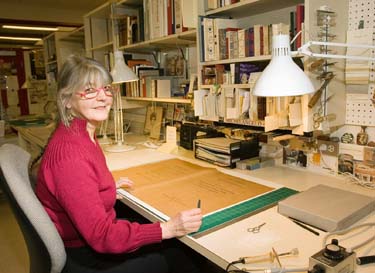The Harlan Hatcher Graduate Library is not just a place to quietly study or check out books. Its eighth floor also is home to one of the largest papyrus collections in the Western Hemisphere.

Although papyrus, made from the stems of papyrus plants, was used 5,000 years ago as a writing material, U-M’s papyrologists focus on papyri written between the Greek conquest of Egypt in the fourth century B.C. and the Arab rule in seventh century A.D., when a mixture of cultures and languages existed in one place, providing a rich, complex history.
Writing existed throughout the ancient world, but papyrus has been preserved best in Egypt because of its dry, desert climate. Most of U-M’s collection consists of poetry, plays, religious texts, tax records, court proceedings and private letters that were acquired from Egypt and written in Greek.
With so many important 2,000-year-old official documents and literary texts around the University, someone needs to make sure they stay in readable condition.
That person is Leyla Lau-Lamb. As the senior conservator for papyrus at the University, she works closely with other conservators and papyrologists to clean and preserve the 10,000 or so fragments of ancient papyri in the collection.
Lau-Lamb was educated in Germany, where she became a registered nurse and worked in cardiovascular health. When she came to the United States, she worked part time at a bookbindery.
“I liked what I saw there,” she says. “I was just fascinated by what they were doing. After four years I worked myself up to working on old books and then I saw an opening at U-M for a conservator position.”
She started at the University as a book conservator in 1980, and her interest soon expanded into the papyrus collection as well.
“I grew up doing things with my hands,” she says. “My family didn’t buy presents, we made them. When I work on books and papyri, I feel like a surgeon.”
Not only does Lau-Lamb conserve the University’s papyrus collection, she sometimes makes her own, from harvesting the papyrus plant to putting perpendicular wet strips of it under a heavy press for a few days to create paper.
“I make it for teaching purposes. It’s very interesting to reproduce what they did 2,000 years ago in Egypt and to see how they did it,” she says.
In 2004, Lau-Lamb attended an excavation in Egypt, where she was able to see papyri coming out of the desert sand and be the first to unroll scrolls and start the conservation process.
She also was one of the couriers who worked on an exhibit at the Smithsonian Museum that showcased early religious manuscripts. ‘Bibles Before the Year 1000’ was the exhibit of the century,” she says. “The Smithsonian had about 150,000 visitors enjoying manuscripts from around the world. It was very exciting to be a part of this and meet curators from Europe.”
Back at the University, Lau-Lamb does not make papyrus, attend excavations or conserve papyrus for the Smithsonian as part of her daily routine. She does, however, work very patiently and carefully to conserve the papyrus that has come into the University’s collection.
Part of her job is to clean the papyri and unroll them, remove any debris they may have and align their fibers, so that they can be mounted in glass. The process involves the use of delicate instruments, including dental and surgical tools.
Without conservation, papyri would be unreadable to papyrologists and scholars. Oftentimes, when they come into the University’s possession, they are extremely dirty, badly folded and even torn.
Lau-Lamb’s favorite part of her work is the variety and detail involved in conservation. She’ll keep doing it as long as her eyes and hands can. “My passion is definitely working with papyrus and on books,” she says.

